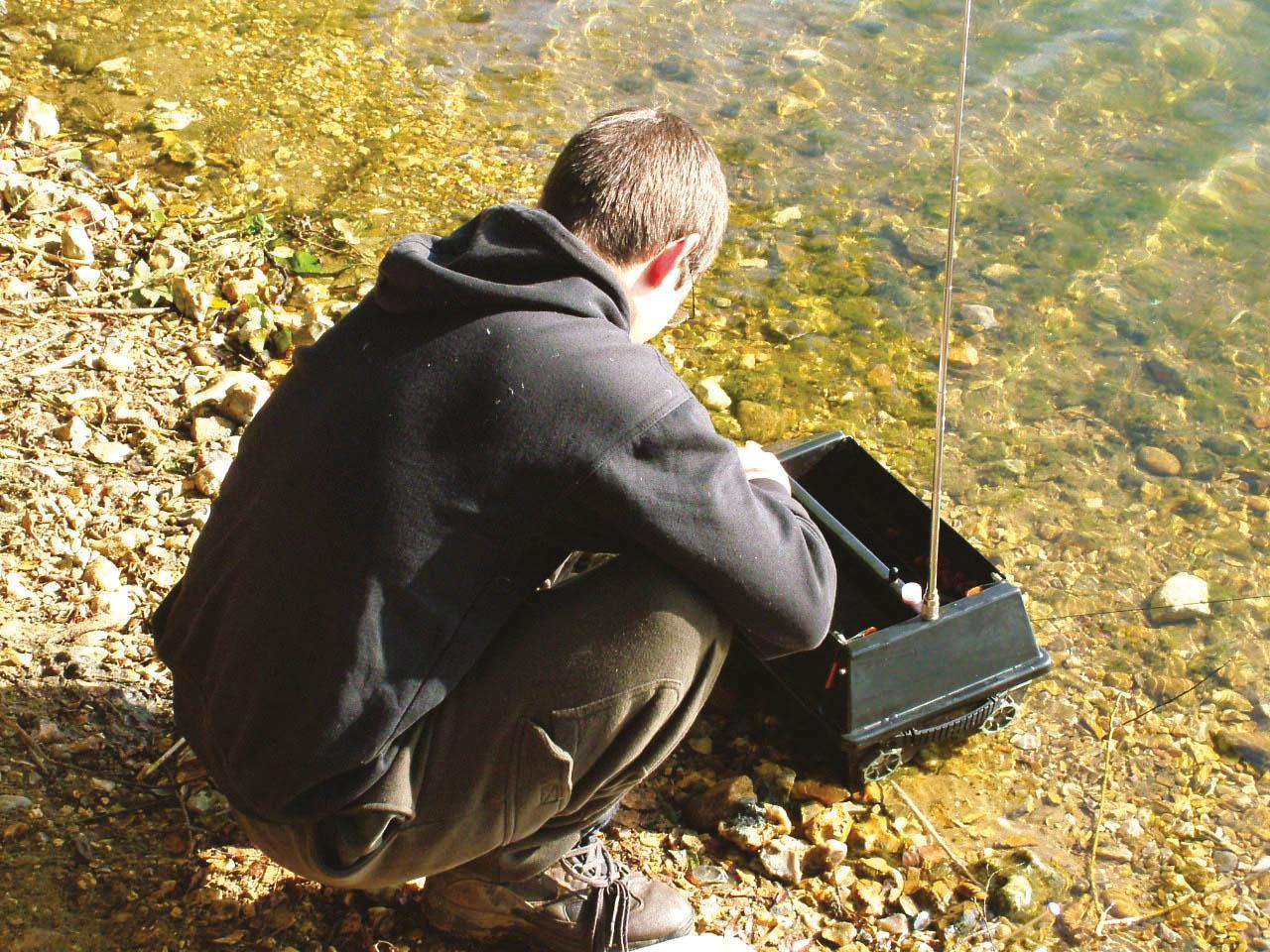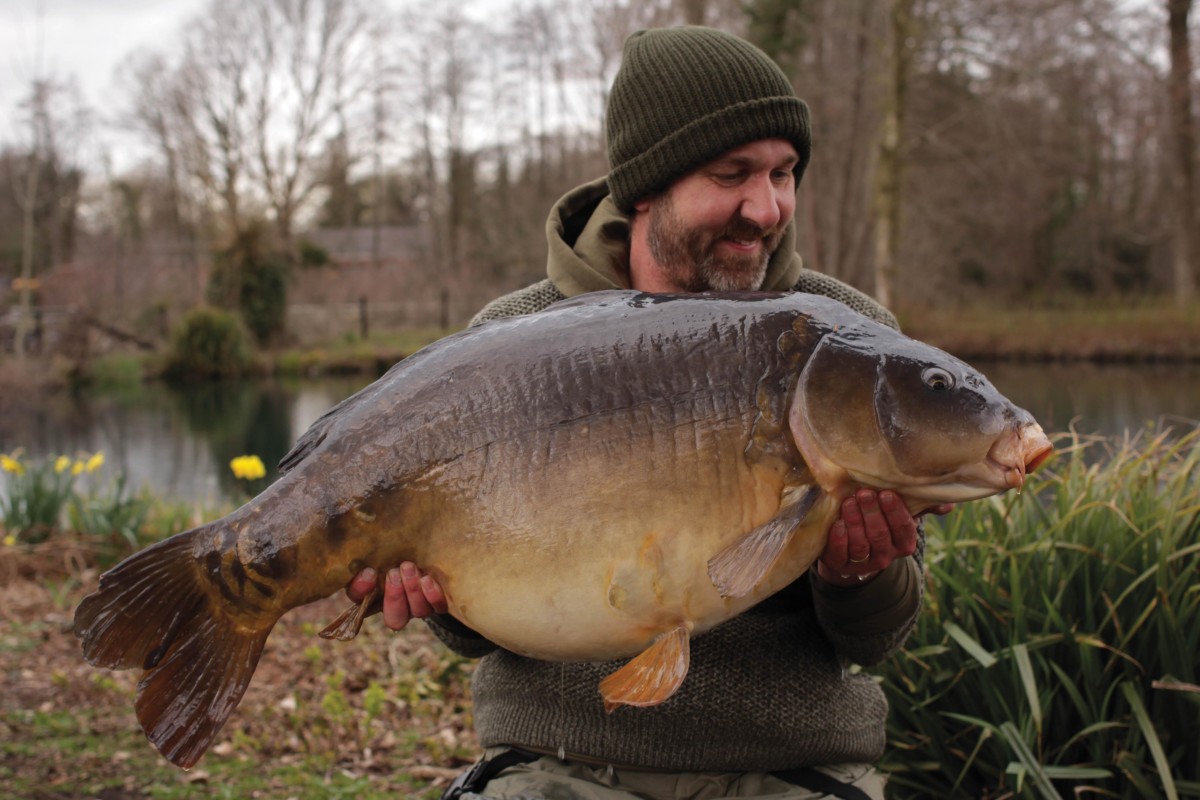
Bait Application Down The Years
Lewis Read gives us his personal take on carp bites, and considers how they, and the methods we use to introduce them have developed over time...
It’s probably fair to say that I have already enjoyed a lifetime’s angling, thanks largely to having the most understanding missus in the world, but also due, in no small part, to an unwavering enthusiasm to continue the ‘journey’. I learned many years ago that in angling, a change is as good as a rest, and as such, I enjoy visiting new venues to keep those embers glowing brightly in my soul.
On occasion, evolution of methods and tackle has been straightforward, having brought about a threshold you cross and would never dream of stepping back from, as to do so could potentially become a limiting factor. Rigs, sharper-than-ever hooks, better materials and ever more effective mechanisms, for instance, ensure that your rig reacts with ruthless efficiency—you know how it’s working, because you can see the hook-hold.
Bait, however, was always a far more enigmatic aspect of the universal approach, and it has been both a fascination and source of constant cogitation throughout my angling during that time. From early disasters, like overdoing one ingredient and rendering an entire complex and quite expensive sack of base mix utterly unpalatable to the fish (at least until the mixture had been cut to make it edible), to having access to some excellent ready-made bait (boilies) that saw the question of whether or not they will eat it become unnecessary, it’s always been a truly captivating topic…
BOILIES: BACK THEN, NOW, AND THE BIT IN BETWEEN
Whilst I could pretend to understand how a carp’s olfactory system works in fine, molecular detail, the truth is I don’t, but I have always had an amateurish, geeky interest in the world of bait, and as such, I felt it necessary to create my own, sourcing ingredients and attractors myself.
Looking back, this wasn’t an explorative endeavour that was done truly in solitude, as my peers would pool knowledge of this flavour at that level. It would be a case of this amino mixture works, that sweetener is great, that flavour should be kept at a low level, etc. It was a theme common to groups of anglers on every lake being angled on around the country, and it was all very exciting.
Time was spent considering a bait’s nutritional balance and whether (digestible) proteins were the key. Later, thoughts turned to highly digestible wholefoods that supplied the fish with almost everything they needed. It was easy to get bogged down in the technicalities and the micro-details, and as such, the new era of good baits being on tap has thankfully suppressed the struggles and the doubts. The thing is, a really good bait makes such a difference, so it was worth the stress and the effort, and whilst that is still true today, the chances of you or I, as laymen, coming up with something truly better, are really pretty slim. There are anglers who have a lifetime of knowledge, time to roll bait (or the money to have someone else roll it for them) and access the most amazing ingredients that work out at £20 a kilo. What they produce would probably outfish most commercial baits, but life balances make that path a step too far for most of us.
The compromise is to choose the best commercial bait possible, with considered application and good angling making the difference, and when used in reasonable quantities (whatever happened to baiting teams?), a decent commercial foodbait can be established. It will then dominate the captures as the carp become focused on finding this readily available food source.
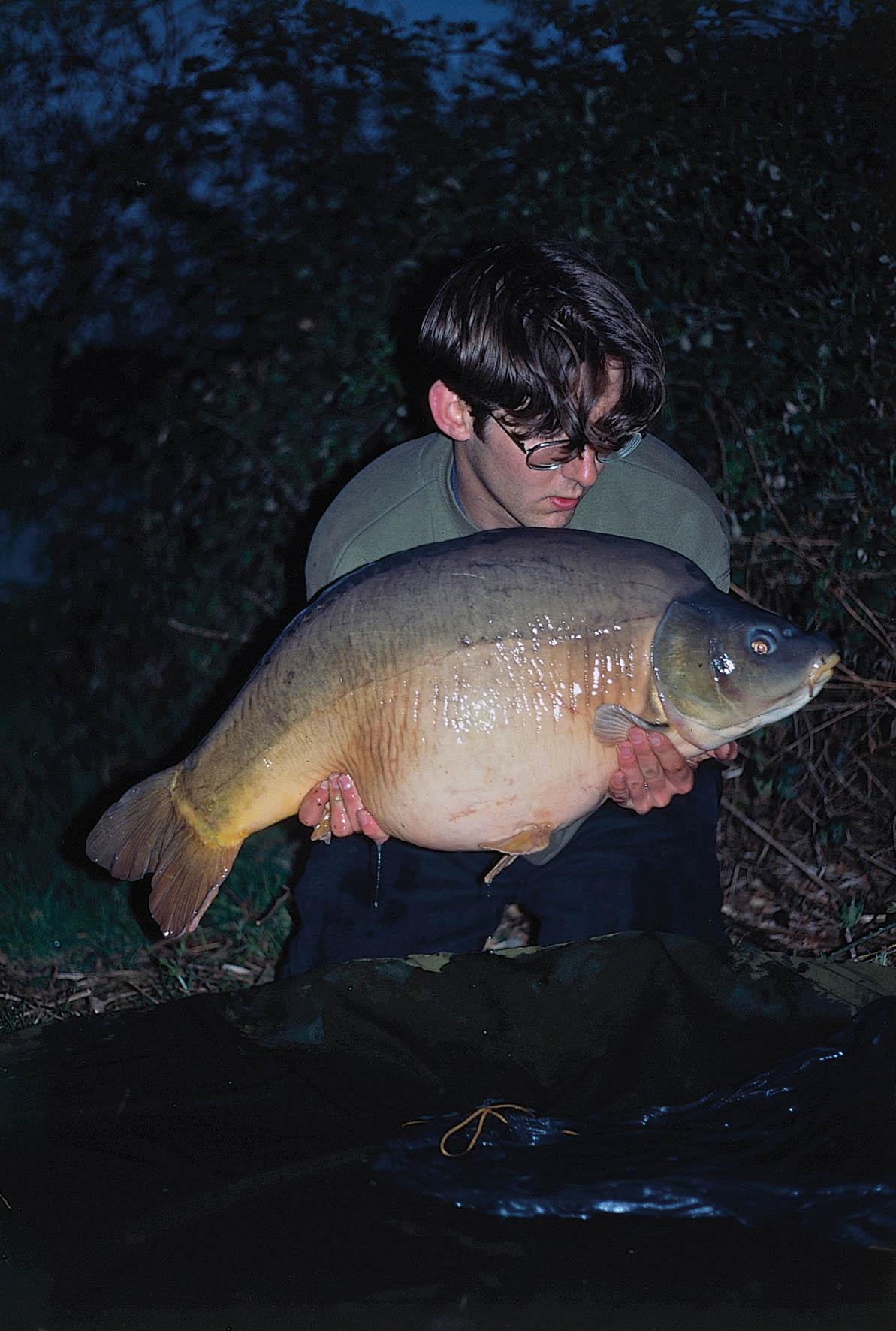
Bait fads have come and gone, but the basis of offering fish a foodstuff that enables growth and repair is the true cornerstone of boiled nutritional baits. Since Wilton and Co advocated high-protein (milk) baits, through fatty fishmeals, birdfoods (which tended to have a degree of protein content) and onto various nut mixes, and combinations of all the above, the better baits have tended to combine awesome attractors with a digestible and palatable base. But what then of tiger nut-meal baits that have dominated some lakes, sometimes for really long periods of time, too?
My take on this is pretty straightforward. If the venue offers a massive volume and diversity of naturals, it seems that the fish sometimes don’t want for anything. In which case, they’ll revert to being akin to kids in a sweet shop. They’re just animals, so they are going to like some things, even if they aren’t necessarily good for them. In the future, perhaps we’ll have to use more vegetable-based ingredients as we continue to pollute and rape the sea—now there’s a cheery thought!
Boilies have always featured heavily in my angling. That’s down in no small part to my sessions being mainly worknights (a couple of nights at a time at the most), and a deep, burning desire to get my freebies out to rigs without use of any carp-scarer devices. Even on waters where other anglers catch loads over spodded areas, I still vehemently believe that prudent use of a throwing stick or catapult has enabled me to catch carp quickly, rather than my having to wait for them to return after I’ve scared them off. In shallow water or quiet corners, under overhangs they like, or wherever else, a softly-softly approach has always worked far better for me compared to the more gung-ho–crash-bang-wallop method of using shedloads of bait that seems to be many anglers’ mainstay.
Anyway, boilies have always been evolving. This has sometimes been driven by legislative restrictions and enforced changes of ingredients, but also fluctuations in food availability, and even the availability of individual additives—like original L-Zero, for instance—but most of the time, that progression has been thanks to new and novel alternatives that have been developed. The world of bait is constantly being reinvented, to become better than ever it was before.
I still follow a simple ethos with boilies: find a bait they like almost everywhere and don’t change, and that way you can concentrate on your angling. From that perspective, little has changed, although great baits are now available to all of us.
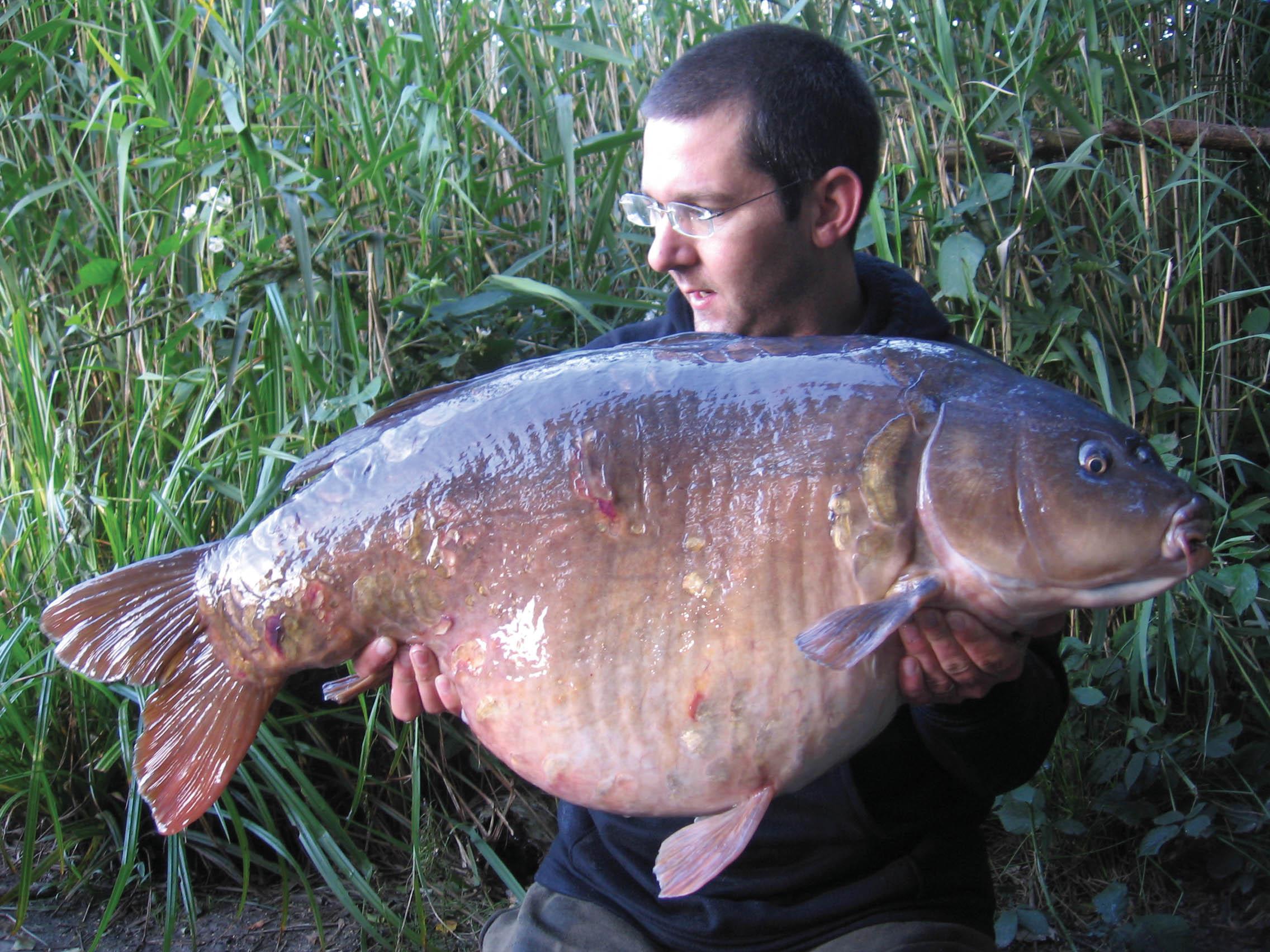
HOOKBAIT—HYPE OR HYPERBOLE?
Whilst developing a base mix is a complex procedure—and expensive and time-consuming, quite frankly—I have always considered that associated with making bespoke hookbaits much easier for us mere mortals. As such, they are far more accessible, and creating a unique attractor blend that worked always gave me a real buzz. It feels like you have done that little bit more to ensure an opportunity comes to fruition by way of a wet, smelly net, and a big cheesy grin in a photo of me cuddling a carp (I know, I am so uncool!).
From my earliest attempts at dry-frying and microwaving Scopex specials, to using polystyrene ball inserts (weren’t they a load of old tosh!) and cork-balled wafters and pop-ups, the evolution has been driven largely by rigs that require consistent buoyancy, sometimes during over-extended soaks. As such, we tweaked base mixes to see that baits remained firm and not swell too much, with them releasing attractors slowly without allowing the mechanics of the rig to be impaired. Sieving, grinding, adding gelling ingredients all worked, made a difference and felt right.
Now, just as with base mixes, our busy lives and priorities seem to see more people buy beautifully crafted cork-balled pop-ups that have been developed and tweaked to a quite amazing level of excellence. The same can also be said for match-the-hatch, ready-made pop-ups and wafters purchased from mainstream companies like Sticky, and these are more than good enough for the most popular rigs used today.
If you need something more specialised, then there are companies that offer handcrafted hookbaits that are a bit different from match-the-hatch offerings, and as such, they make up a significant portion of the market. Having said that, given the number of corkballs we sell, there must still be a significant core of anglers that stick with making their own, and for good reason, too… a well-made, cork-balled hookbait is a thing of abject beauty.
I’ve found myself in an in-between place. I tend to use a couple of select pop-ups sourced from friends who make hookbaits, but for most of my own fishing, I use pimped-up Sticky Baits wafters or pop-ups that have been given multiple glazes of a hydrolysate, enough to enhance long-term attraction, but not so heavily glugged that their buoyancy is affected.
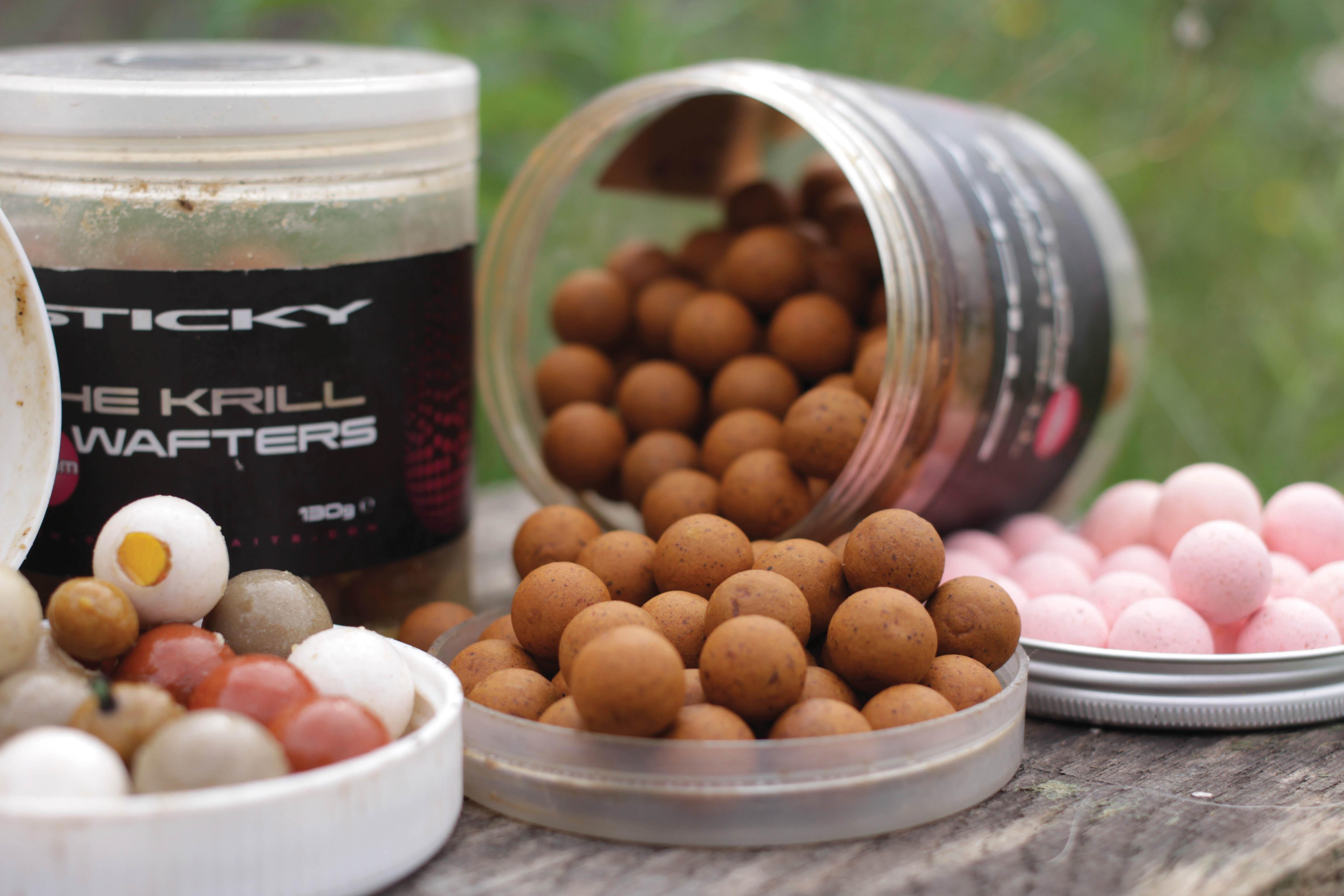
PARTICLE PROCRASTINATION
I am guilty of using big words, but in this case, ‘procrastination’ not only reads nicely, it also implies my issue with what is, historically, an immense method and long-term approach that works almost everywhere, i.e. mass baiting with small-seed mixes—that invariably include hemp—to induce a feeding response that encourages fish to forage over an area until the bait’s all gone. Reapplication creates a response over a longer term, which then builds the fishes’ confidence… blah, blah, blah… it’s all so etiolated and slow!
So yes, my issue is it generally takes far too long: too long to prepare the mix, too long to apply it, too long for the fish to return after spodding it and too long for the fish to find the hookbait when they are browsing across a carpet of freebies. Yes, I’ve seen long-term anglers have amazing results on big beds of seeds, but for the most part, they’re single men!
Realistically, little has changed in the world of particles. The methods of preparing different particles hasn’t changed—and if you read books published from the ’90s onwards, there hasn’t been any leap forward.
Fish feeding with their lips tight to the lakebed and barely moving their heads make catching carp difficult, and for that reason I prefer, nay love using larger particles with boilies to create a more varied feeding situation, and that is where my deepest confidence lies. Larger, oily nuts (not rhizoids, which are ‘wannabe’ nuts) tend to sink slowly and hang up in weed, and as such, they add a great additional dimension to angling on weedy venues, or just the magic of the nut crunch and head-lift feeding on others.
Of all the additives I have ever used with my nuts (oo-er), I am still sold on one, and whilst there are other L-form, amino-based sweeteners available that end in ‘tin’ or ‘lin’, the one with the ‘B’ suffix remains somewhere between magical and amazing. By using large particle, I think it’s easier to hook ’em within a reasonable time frame.
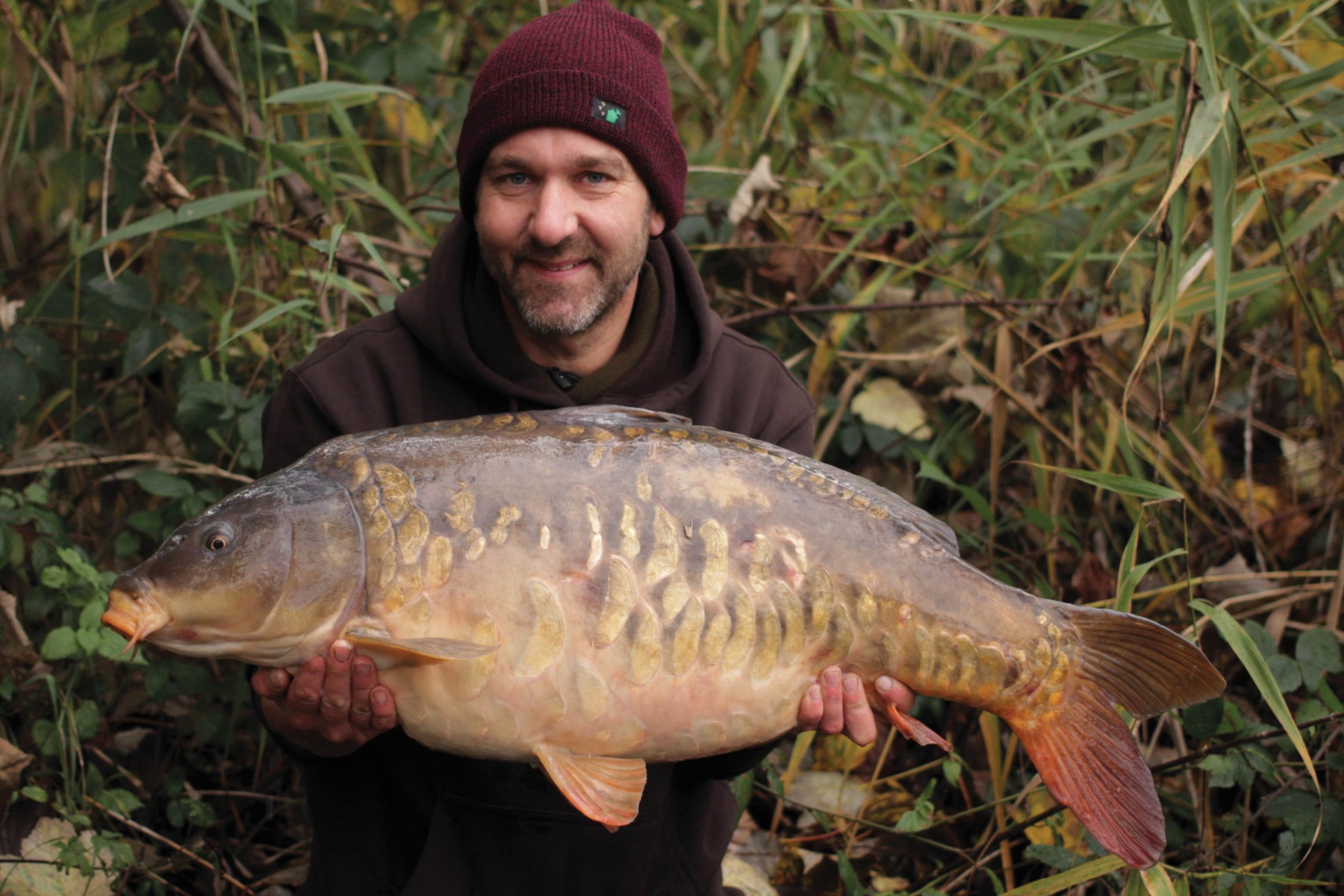

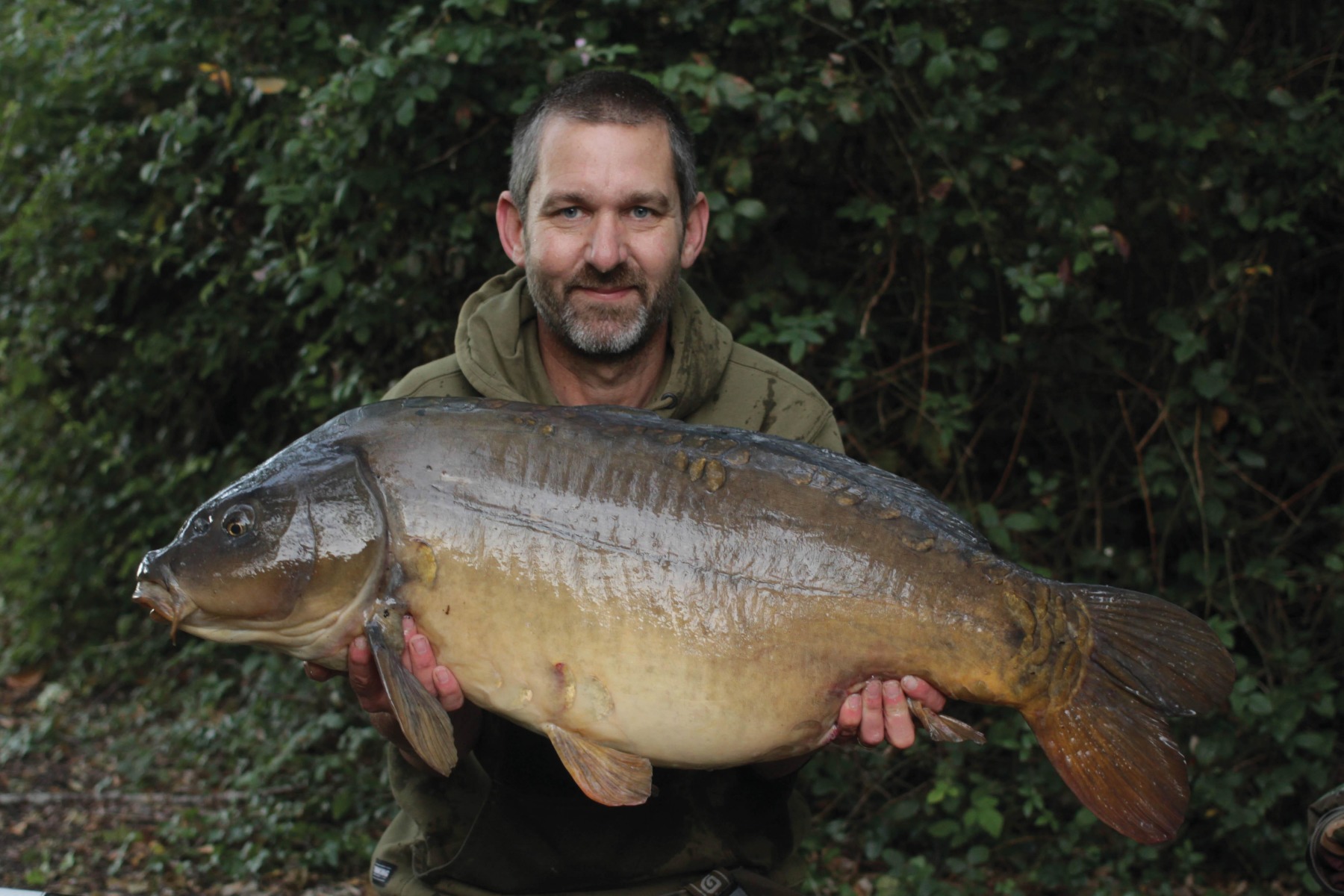
THE COLD-WATER REVELATION
Just as Zig Rigs opened up an exciting new dimension to winter fishing, allowing us greater, more productive cold-water angling on a wide array of carp venues, the leap that preceded this was the revolutionary reinvention of the use of naturals.
What was one of the very earliest carp baits, came to fore, and it allowed us to catch carp with more regularity from late autumn on, through the winter months, right the way into spring, when rising water temperatures mean that either silver fish are so active they annihilate the bait almost as soon as it goes in—or at least, so quickly the carp don’t get a realistic look-in—or the wriggly little blighters disappear into the sediment as they are not virtually paralysed by the cold.
Maggots and casters, and indeed, other naturals that are obvious but I won’t dare to mention for fear of swift and violent reprisals by an angry bloke based in Cambridgeshire (cue Lew-Lew chuckling insanely), allow us to broadly emulate a carp’s major natural food sources, namely invertebrates such as bloodworm, and as such, they have no lifespan. They don’t ‘blow’, but they have been increasingly misused, to the point where fisheries necessarily bring in volume restrictions, or ban them completely!
I have two things to say regarding this soul-sapping scenario (both may be a little controversial, but hey-ho, the truth hurts):
1. This stupid and extremely selfish practice was/is seemingly propagated from high in the carp–match-fishing scene (the source of all evil!).
2. I hate prescriptive/restrictive rules that have been introduced due to an idiotic minority who follow selfish practices—propagated from high in the carp–match-fishing scene (the source of all evil!).
Rant over—for now!
I think it was the lovely ‘Nernie’ Lofthouse (and the famous ‘sir’ Bob ‘Mayhem’) who contributed to the reemergence of the maggot as the cornerstone of a method that became dominant around these parts: the mighty Mag-Aligner Rig.
‘Nippers’ may have missed this one, but trust me when I say the method is amazing. The combination of a big sock of maggots and a diminutive hookbait on a soft link showed what you could catch from lakes, rather than what we were achieving. If there was a single significant aspect of the presentation that made the biggest difference, it was the sock of maggots creating a patch of wriggly things that seemed irresistible to carp. That’s how it was then, just like it is now.
Moving forward a decade and a half, it’s still the core of my winter-fishing approach, as is the PVA mesh bag of maggots. All those lovely individual food items take a while for those horrid things with claws and reinforced chitin carapaces to clear up, and it exudes natural attraction (waste, excretion), movement and a binary visual draw. Additionally, with each bite the ‘germs’ are spread around the swim as the carp coughs out the mouthful of wrigglers when they feel the cold steel take hold.
Of course, casters became popular a couple of winters ago, with sales of both real bait and Enterprise Tackle’s fake ones booming thanks to ‘HRH’ Hearn! You could hear secret carpers weeping across Europe as they all mourned the outing of something very special indeed. That crunch and ooze must be amazing to fish, the noise and liquid escaping through puffing gills stimulating others to join the frenzy.
I’m not going to say anymore for fear of my own safety! I reckon you get the gist, though. Expanding your repertoire to include live baits for cold-water seasons is a game changer. I only wish I knew about them earlier, and their application has only improved as more anglers consider new ways of catching carp with them.
Looking after your germs is something people like to prattle on about a lot. My take is simple: as long as they haven’t sweated up and stink of ammonia, then I think they’re good to go!
Of course, fresh is best, but you really have to do well to muck them up that badly that they’re rendered less effective. Store them in a ventilated bucket or maggot box in a cool place, and don’t forget some maize meal when you buy them.
Realistically, if they’re kept in a fridge, they’ll normally last until the following weekend, and if a few are casters, well that’s a Brucie Bonus, isn’t it?
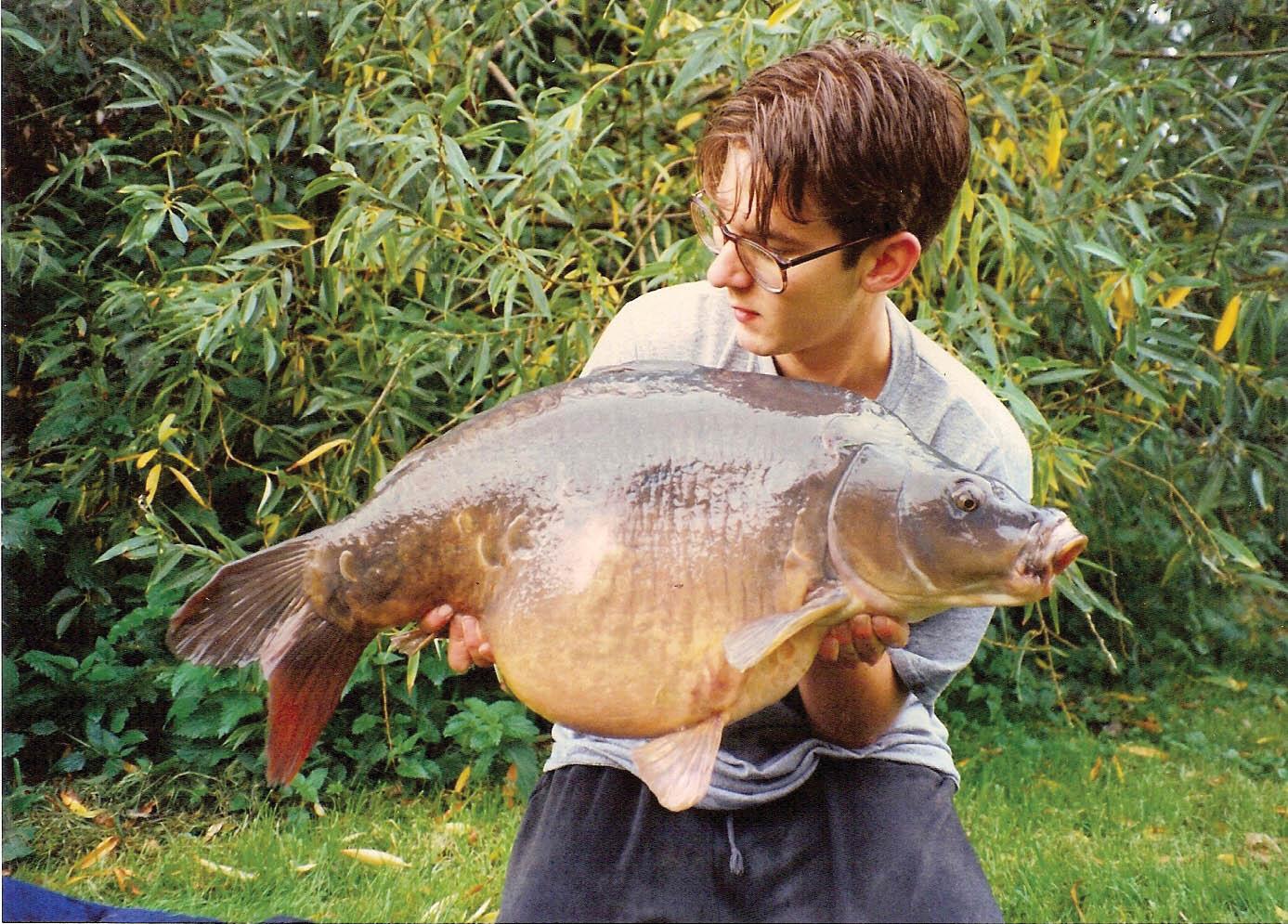
APPLICATION AND ESTABLISHING—THE LONG ROAD
With the proliferation of angling, it’s been a few years since I’ve seen an individual manage to establish a boilie to such an extent that it dominates a lake (and to the extent that other anglers struggle) as fish favour ‘the’ bait. In fact, the last time I did it was about 30 years ago on a small lake in Shepperton, when fishing for Tet’s Pet—before it swam down the road to live in a much larger and quieter pit in the Colne Valley.
Regular baiting with the nut mix of nut mixes achieved this state of nirvana. It was a bait that started as a simple blend of crushed peanuts, a boilie mix and protein mix that evolved over a couple of decades to be little balls of delicious, nutrient-rich confidence. The soluble ingredients leached out and the blended, crushed-nut matrix expanded to fill the gaps, which meant that the baits retained a degree of firmness, but would mush if you applied a little finger pressure after a soak. Oh, how I look back at that bait with a warm glow and a wry smile. Like most anglers, having something unique was special, and it added to the buzz of a capture.
Commercial baits now are just superior in every way, and as I currently prefer to expend my energy on catching carp rather than rolling bait, the convenience factor rules. I do, however, sometimes wonder whether I should resurrect it one day—maybe when I retire!
Bait is now applied in much greater quantities than ever before. This makes it difficult to establish a bait the same as we did. Bait teams seem to be a thing of the past. Instead, a loose commune of bait users develops when anglers ‘follow my leader’ on a bait that is successful, and if the majority of anglers get on the bandwagon, that can tip the balance and make a single boilie dominant.
We all fish differently, with different time available and with starkly different aspirations, and choosing a bait they readily eat, does them good (offers long-term benefit) means that I prefer to fish for bites. I always apply the bait I have to as many spots as possible, as I do not want to be tied to a single swim or spot. Surely a carp finding your bait in multiple locations will help to establish it, more so than merely developing a spot? This is something that hasn’t changed for me for decades. Choosing to naturalise a food source, rather than get them on a spot means that I can fish for carp wherever they are, and be confident they have eaten and enjoyed that bait around the pond at some time. We all have our funny little ways, and I can’t see me ever reverting to big-hit fishing and sitting in a swim anytime soon, on the waters where I angle.
As I’m not reliant upon applying large quantities in one spot, spreading it about like a sex-starved nymphomaniac, I tend to still bait using similar, timeless methods—throwing boilies in by hand or with the aid of a catapult, or for a scattering at range, via a carbon throwing stick. I’ve found that even in shallow water, such as on ‘Welly’, it’s possible to get enough bait out there to bring about a bite, especially if it’s raining or windy, as the turbulent conditions really help to mask the sound of the boilies hitting the water.
None of this is, though, is any different to how it was 30-plus years ago. To be honest, I rarely bait with particle, as it’s not possible to do so quickly and quietly, unless it can be hand-balled to an edge spot—I’ve explained that I like a wider spread of bigger particles elsewhere in this piece, so I won’t bore you with repetition—I’m not your missus!
I should admit to owning (and loving!) a bait boat. I’m allowed to use it only on Burghfield. The bait-application possibilities are almost endless, especially if I do multiple runs to spread it, but I would hate to rely on it, and feel a greater sense of achievement if I catch after casting.
Likewise, I own an old-style baiting pole—it came out once a few years ago, too! Truth is, it has caught me a few carp. Precision is awesome, but its range is obviously limited. One day I’ll invest in one of those connecting-pole things that Beaky hauls with.
Everyone loves a moan, and mine today is about spods. Doing worknights, I deeply despise the noisy swim-emptying things—probably ’cause I’m no good with one. Instead, I prefer the ‘bomb’ thingy that opens up mid-air (CARPology: Airbomb). It’s not perfect and range is limited, but the spread is cool and the noise made when using one is far less significant. I had a bite from ‘Engie’ a couple of weeks ago within half an hour of putting some bait out, and I suspect I wouldn’t have done if I had used a noisier alternative. (Wow! You see, you can teach an old dog new tricks sometimes.)
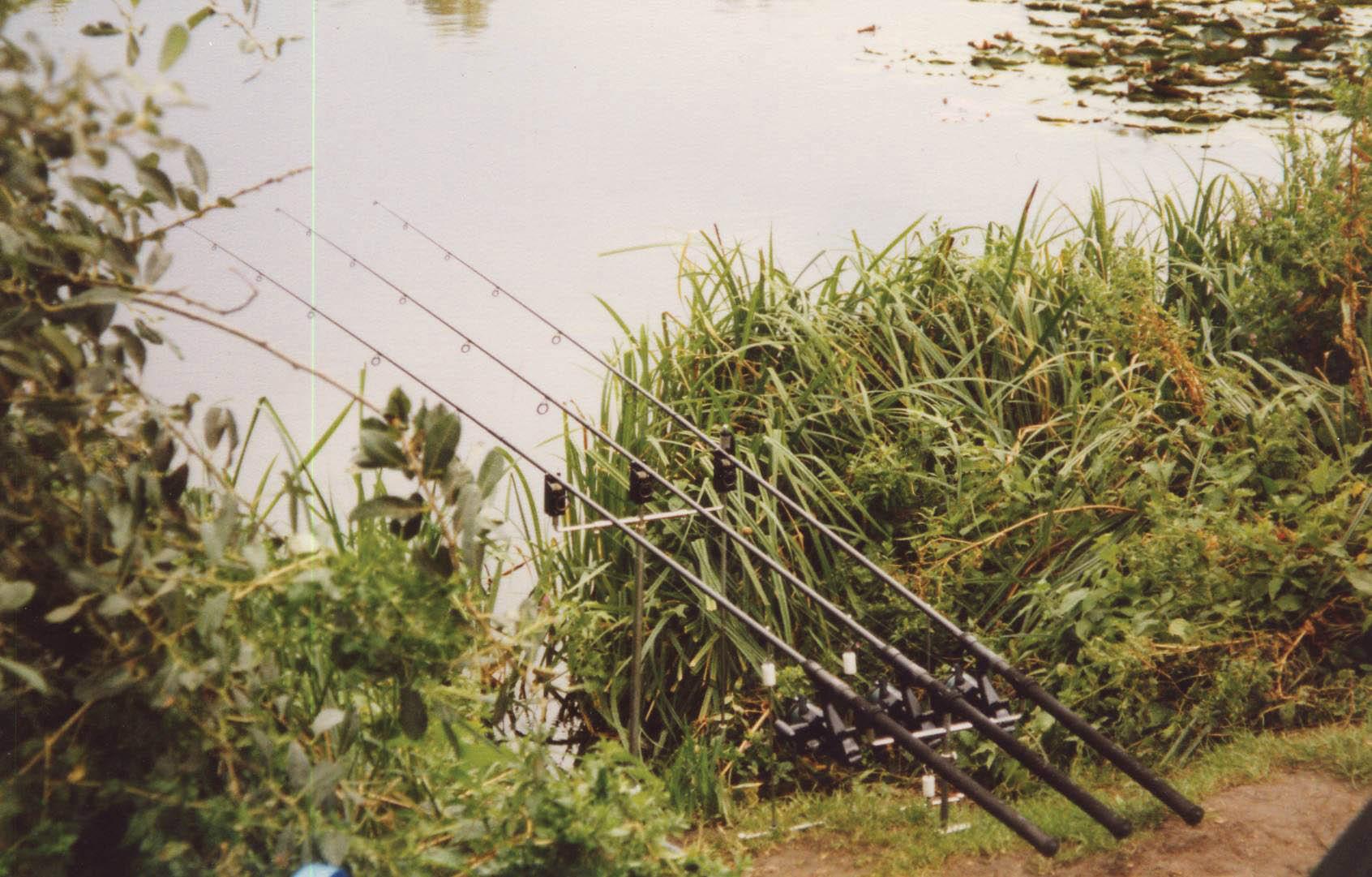
GENERAL CONCLUSIONS—RETROSPECTIVE RAMBLINGS (OF SOMEONE WHO FEELS OLD, HAVING WRITTEN THIS ARTICLE)
When I first started this for the mouse nest-haired editor-in-chief, I wondered, How on earth am I going to write 2,000 meaningful words on this topic? but in truth, the impact of how, where and what bait we apply is intrinsically woven into our overall approach. What we use and how we use it defines us, individually, and whilst you may disagree with the hows, it’s worth sitting down and thinking about your own approach, logically analysing your own methods and reflecting on historic campaigns, successes and failures, and reminding yourself of the key elements of what you learned along the way.
Good bait makes a massive potential difference to your results, but other elements also need to be right—the whole thing slowly progresses as you fish and fish and fish. Maybe for some, there have been singular quantum leaps, like the original boilie and the Hair Rig, or Bernie’s Mag-Aligner, but for others it’s an evolution, and learning and developing as an angler. Bait is just a vital aspect of that learning process, and consequently bait, bait application and associated methods (specialist rigs) have steadily evolved. We’re due another lurch forward soon…
